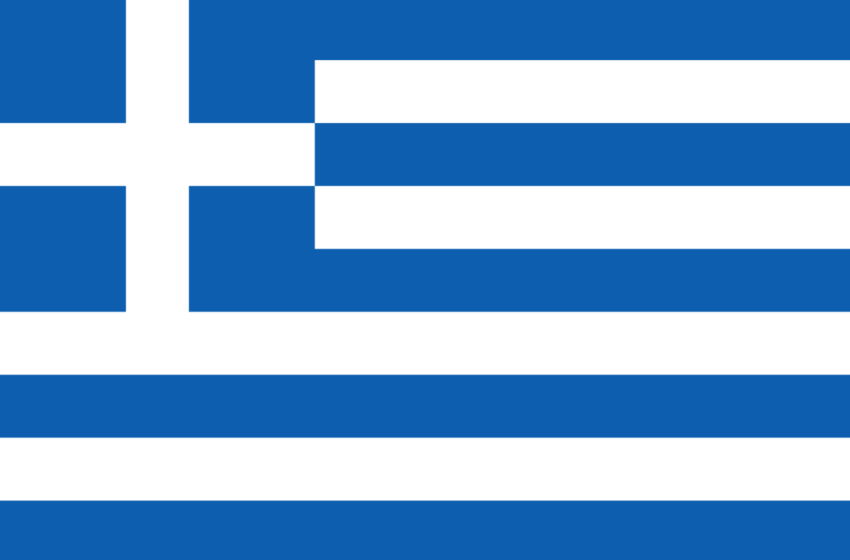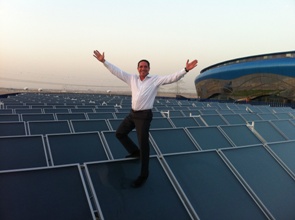Greece: Sole’s Pool Heating Combines Geothermal Heat Pump and Solar Collectors
February 5, 2014
The new swimming pool complex in the sports centre of the Amaliada municipality in the Greek province of Ilia is heated by a combination of solar thermal collectors, three warm wells and an electric heat pump. An oil boiler serves as the backup system. Greek solar collector manufacturer Sole, which supplied the solar thermal system and was also responsible for planning it, says it is Greece’s only hybrid pool heating system combining a significant share of solar thermal and geothermal energy. The system cost around EUR 600,000 (including planning and installation) and was financed entirely by Greece’s Green Fund. The municipality is the beneficiary of the fuel savings.
The hybrid system provides heat for the Olympic-size swimming pool and another small pool, for the changing rooms and general infrastructure, as well as for domestic water needs. According to Sole, the 550 m² solar flat plate collector system supplies 27 % of the 1,285 MWh of thermal energy per year. The main share comes from the geothermal heat pump, with 54 % from the geothermal source and 14 % from the electrical input. The oil boiler only works as a backup when solar thermal is not able to provide the hot water. Its share will be 4.5 %, according to simulations.
Heat pump source: the town’s drinking water wells
The Amaliada municipality has three operating wells, which provide 200 m3/h of water for the town. Because the water has a temperature of 18 °C, it can be used as a geothermal low-temperature heat source for the two heat pumps with 0.8 MW of thermal output each. The solar collectors’ main function is the efficient production of hot water at 70°C (80°C in the solar circuit in shoulder season), but excessive solar heat also support the pool heating through the one heat exchanger in the small pool and the two heat exchangers in the Olympic one. There is no extra heat storage tank. Thanks to the solar collectors, the heat pump has a shorter operation period, saving much standby energy in the shoulder season.
In winter, the system changes operation modes and the solar collectors now supply 50 °C warm water as an energy source to the heat pump. “We recommend this combination for any location, especially if there is a water source. When there are no sources available, we recommend combining the air source heat pumps with another control strategy,” Christos Koustibis, Sole’s Public Relations and Communications Manager, says.
There are plans to use the excess heat in summer for solar thermal air conditioning of the adjacent indoor gymnasium with a floor space of 2,500 m², so that the already existing installation can help save even more money in operating the sports facilities.
System payback: 3.5 years due to oil price increase
Oil prices have recently taken a turn for the worse in Greece (see http://solarthermalworld.org/content/greece-urban-citizens-struggle-pay-heating-bills). The hybrid system replaces an oil boiler and will save 80% of the fossil fuel consumption. This means that the payback period will be 3.5 years, based on current oil prices.
The pre-feasibility study was carried out by the Centre of Renewable Energy Sources (CRES), located in Pikermi. The control strategy was designed by Dr Michael Karagiorgas from the Greek School of Pedagogical & Technological Education, ASPETE, and is based on patented know-how from solar-assisted heat pump technology.
Sole supplied the solar thermal system and was responsible for planning it in collaboration with the mayor of the Amaliada municipality, Ioannis Liberis, and technical service provider Doxa. The supervision, commissioning and operation have been taken over by Bonair, Sole and the technical department of the municipality of Amaliada.
About Sole:
According to the company’s own information, Sole was the first Greek enterprise to venture into the renewable energy sector. Another innovative solar project by Sole, which was founded in 1974, can already be found on solarthermalworld.org. The manufacturer exports 70 % of its production to a total of 35 countries.
More information:
ASPETE web.aspete.gr/aspete/ (in Greek)
ASPETE (in English): http://www.aspete.gr/index.php?option=com_content&view=article&id=393&Itemid=26&lang=en
Greek Green Fund: http://www.prasinotameio.gr/index.php/el/


